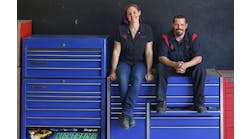When readers were asked on the Ratchet+Wrench Facebook page what they believe pull customers into independent auto repair shops over dealerships, answers ranged everywhere from “friendliness” and “price” to “trust” and “speed.”
It is no secret that dealership service centers and independent auto repair shops continue to be each other's biggest competition. Both have their own advantages and disadvantages for customers—and with dealerships receiving the criticism of being less personable than independent repair shops, service-focused trends have become commonplace in the world of fixed operations.
So what are the specific factors bringing potential customers over to the competition?
Cox Automotive, a global automotive technology and services company for dealers, conducted an online survey of 4,455 participants to discover what consumers are saying about the subject. The Maintenance & Repair Study lists the top five reasons customers choose to give their business to dealerships as:
- Vehicle knowledge
- Certified/highly qualified technicians
- Knowledgeable staff
- Use of genuine parts, tools, and diagnostic equipment
- Explanation of services rendered/comfortable waiting room
Ratchet+Wrench spoke to industry consultant Bill Haas, successful dealership owner Evelyn Chatel, and “dealership alternative” repair shop owner Mike Keane to break down and identify some of these factors as well as identify current strategies they believe are driving dealership success—and what independent shops can do to compete.
“I think that consumers believe that when they have a new car, dealerships are more prepared, in terms of the technology and the training for the technicians, and things like tooling and equipment,” says Bill Haas, owner of Haas Performance Consulting. “They do that without understanding what the capabilities are outside of the dealership.”
Expert Technicians
The Dealership Strategy
Evelyn Chatel, owner of Freedom Toyota, emphasizes the importance of training at her dealership in Harrisburg, Pa.
“Training is a big thing for us,” she says.
Each of Chatel’s employees has the opportunity to attend technical and leadership training, all at the cost of the dealership. She says this helps the Freedom Toyota technicians become more well-rounded and successful employees. Chatel believes in training so much so that the topic becomes a large part of each employee’s yearly review.
“We make sure that yearly evaluations are based on the employee’s participation in training, and what they’ve done to get themselves more training,” Chatel explains.
Employees will be asked how much training they have participated in during the year and how much they put forth to better improve themselves. Chatel says that at the end of the day the improvements that employees make only help to improve the experience of the dealership.
A 17-week training program on how Chatel’s employees can learn to communicate and trust each other has also been added to Freedom Toyota. The ACT program stands for accountability, communication and trust, and aids to her employees understanding the unique cultures and environments that different individuals bring to situations. This program has become wildly successful for Freedom Toyota’s culture.
The Independent Solution
According to the Ratchet+Wrench 2018 Industry Survey, over 77 percent of independent repair shops have their employees attend industry-specific training at least once per year. As much as this percentage could grow, it is apparent that a majority of shops have members of their team attend training. The opportunity arises in how shops can publicize this training to potential customers, says Haas.
If one of the largest reasons customers choose dealerships over auto repair shops is “trained and highly qualified technicians,” those customers need to be aware that the technicians in auto repair shops are equally as trained and qualified.
“The [training] information has to be prominent on your website, so that the first impression [customers] get when they go there, is that you are capable of taking care of their car,” says Haas. “The consumer today is going to spend time checking you out before they come in to you for service. No matter how it happens, potential customers are going to get to the shop’s internet presence before even making an appointment.”
Mike Keane, owner of Keane’s Autoworks in Bedford Hills, N.Y. and Ridgefield, Conn., has the phrase “The Dealership Service Alternative” front and center on his website. Keane says a customer gave his shop that title, and ever since, it stuck. Keane says locals now treat them like every other dealership.
Keane’s website also profiles their technicians’ training. On the bottom bar of each website page it says “Experienced Technicians” with a short description of their knowledgeable staff. More information on the specific trainings their techs have is below the title “Our Technicians Have the Auto Repair Experience You Want” under keanesautoworks.com’s “Services” tab. This information is readily available to all that visit Keane’s website.
Haas says other opportunities to broadcast your talented and knowledgeable technicians can come in the form of blogs, videos and social media posts.
“If I just had two technicians go to training on some new technology, I should share that with everybody,” explains Haas. “ That should be on my Facebook, that should be on my Instagram, I should be putting out Twitter messages. You need to use all of those vehicles to communicate that message.”
Videos and blogs can be as simple as explaining that the shop’s technicians have recently been certified in hybrid vehicles, and what services are now offering, says Haas. These additions to the shop’s online presence will let potential customers know that independent repair shop technicians are comparable to dealerships.
Additional Convenience
The Dealership Strategy
To add ease to the repair experience, many dealerships offer additional services to their customers.
“It’s not about price anymore,” says Chatel, “it has to be the treatment that they receive during the whole process.”
Shuttles and loaner vehicles are commonplace in the world of dealerships. On top of loaner vehicles, Chatel offers her customers something different—a pick-up and delivery service.
“The customer doesn't even have to come into the store, we pick up and deliver their car from work or home, so they don't have to have the inconvenience of coming in,” explains Chatel.
She says that this service has always been a part of their model, but in the past year they have been really talking it up to potential customers. This service has become especially helpful for mothers with young children, says Chatel.
“We try to make it as convenient as possible,” she says.
The Independent Solution
Additional convenience services have been popping up in independent auto repair shops for years.
“I think we see that car dealerships have done a lot of things for their customers that we are finally seeing independent shops do,” says Haas. “Car dealers were the first to provide shuttle services, or to offer loaner cars. Auto repair shops had to catch up to that.”
An extra convenience that auto repair shops can advertise, is their ability to be a one-stop-shop for their customers. All members of the family with all brands of cars can be serviced at the same shop, unlike dealerships. If the vehicle is under warranty or has a recall, customers can come to independent repair shops for their service, even if the car needs dealer work.
“Tell your customer, ‘Bring your car to us and let us do your maintenance, let us do your service, and even for your brand new car while it’s under warranty,’” says Haas. “‘Anytime your car has a warranty issue, a recall, or anything like that, we will take it to the dealer and have the warranty or recall service performed. If you need anything automotive, you come here.’”
That message and added service keeps the car from getting into the dealer service department. Haas says the importance of this is unmeasurable, not doing it risks your customer receiving unknown service. Regardless if the dealership service the customer receives is good or bad, it isn’t worth the risk. Haas says it’s about creating barriers to exist.
Updated Facilities
The Dealership Strategy
“When you look at the dealers’ facilities, you look at the customer waiting areas and they have coffee bars for instance,” says Haas. “To where if you had to be at the dealership getting your car serviced you could actually, if you had your laptop with you, you could be in an a fairly quiet area and do some work.”
At Freedom Toyota, the waiting room is adorned with TVs, comfortable seating, and even massage chairs. This all aids to Chatel’s goal of providing customers with a comfortable place to wait. They also offer fresh fruit everyday, as well as nutritional bars and teas, instead of donuts and junk food.
“We want to try to give people an experience that’s also healthy for them,” she explains.
These small additions add to the customers’ overall experience and comfortability.
“All of those things are important to us because we feel like if they have to come in, we want the experience to be really special,” says Chatel.
The Independent Solution
“You’re seeing today, a lot of independent repair shop [waiting rooms] are ratcheting up to very much the same (as dealerships),” says Haas.
Regardless if a shop has a large or small budget, Haas says the prominent goal is creating a welcoming environment that make guests want to stay there.
“Keep it clean, put in some comfortable chairs and put a fresh coat of paint on the walls,” says Haas. “To me the most important thing is keeping it so the customers can get away from all the noise, all the dirt and the traffic.”
Haas says that one of the things he sees when he goes into independent shops and looks at their waiting room, is that they tend to be in the middle of everything. Customers are placed in an environment right in the center of the chaos. He suggests putting the waiting area out of the way of the work being done.
“This environment, if you think about it, is number one going to be dirty, and number two going to be noisey,” says Haas. “Find a way to get them into an area that is clean—and stays clean, and find a way to minimize the amount of noise and the amount of business that takes place [near it] so they can read a book, or be on their phone/computer.”
How one views their facilities will help cement the mindset of a reputable business and enforces how customers will see the business in comparison to dealerships.
“You need to start thinking of your business as a store, it’s not a shop, a shop is only a portion of the business where work is done. But the reality is, the business is a store and your store sells automotive business and repair,” explains Haas.
Enhanced Service
The Dealership Strategy
In the process of hiring new employees at Freedom Toyota, Chatel makes sure to include an explanation of their customer service priority.
“It always has been, and always will be about the people—we hire people with those intentions,” says Chatel, “we hire people that have customer satisfaction and customer goals before anything else.”
She says that’s what drives their success, the relationships they build from the time of purchase—from the phone operator, to the greeting, to the follow-up with the service advisors, to the availability of the service managers.
“It’s really about spending time with the customers and educating them on where to go and who to call,” says Chatel.
The Independent Solution
To continue to give great service and stay on top of customer retention, Haas recommends attempting to be aware of when a customer is planning on a purchasing a new or used car.
“It is important to know when a consumer is thinking of changing cars,” he says, “ in some cases the shop is probably recommending to the consumer, ‘hey it’s probably time for you to consider replacing this car.’”
If a relationship is formed between the repair shop and the customer, knowing when and what kind of car he or she is planning on purchasing will give the repair shop a great advantage. The shop can now be positioned at the front of the line for the vehicle’s service, by telling the customer to bring the car in to get a comprehensive inspection, it’s a great opportunity says Haas.
Above all, it’s about the service being provided to the customers.
“You have to continue to give great service, that is the reason that people come to the independent shop, because they know they are going to get great service,” says Haas.



